Step into the fascinating world of creativity and wildlife appreciation with these fun wolf coloring pages. Wolves, with their aura of mystery and undeniable allure, have long been a subject of study for artists, nature enthusiasts, and educators alike. In this article, we’ll take you on an educational journey through a curated collection of engaging wolf-themed coloring pages. Whether you’re a coloring aficionado looking for a new project or an educator seeking a dynamic teaching tool, these pages provide a unique opportunity to explore the beauty and significance of these magnificent creatures.
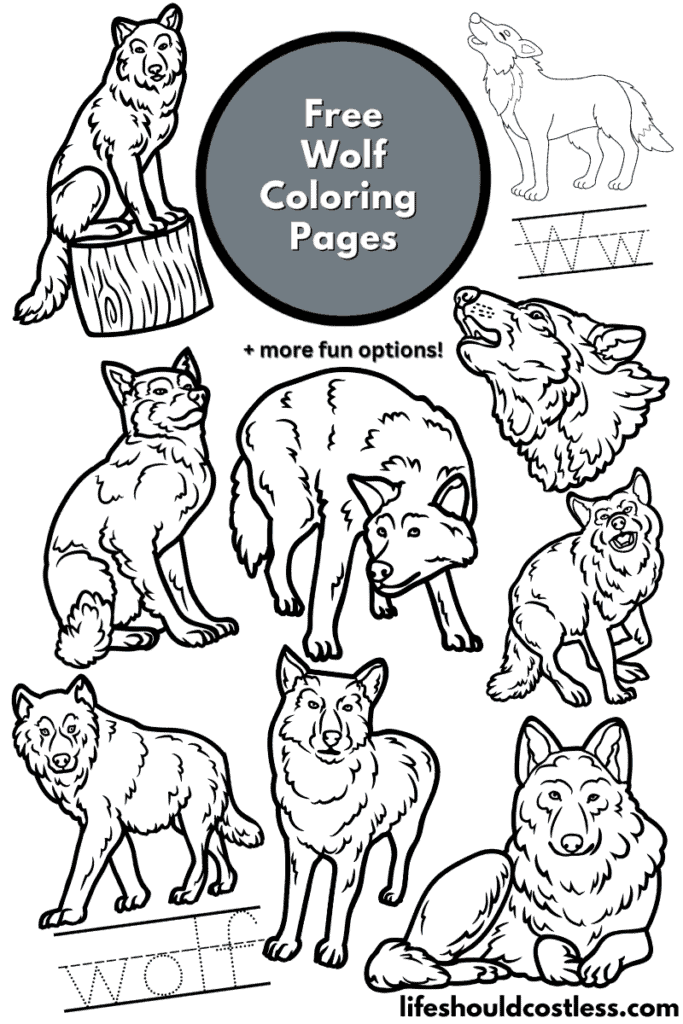
So, get ready to unleash your inner artist as we delve into the world of wolves and uncover the secrets of these iconic animals.
You’re welcome to pick any design that captures your interest. Just select the template you prefer, access the free PDF, print it out, and let your coloring imagination run wild without boundaries.
These templates can also serve as helpful guides for embroidery projects or ignite inspiration for finely-detailed tattoos.
Your creative options are as endless as the limits of your own imagination.
Wolf facts
To those who may be new to my coloring pages, I’d like to highlight that I take pleasure in providing you with the chance to immerse yourself in the subject matter.
This allows you to seamlessly turn your coloring experience into an educational journey. So, with that in mind, let’s begin!
Here are lots of fun and interesting, simplified, facts about wolves:
- Social Structure: Wolves are highly social animals and live in family groups called packs. A pack typically consists of an alpha male and an alpha female, their offspring, and sometimes other subordinate wolves. The alpha pair leads the pack and makes important decisions. Besides the alpha pair, there are beta wolves, subordinate members, and sometimes even older pups that help care for younger siblings.
- Communication: Wolves have a complex communication system. They use howling, barking, growling, and body language to convey various messages to pack members. Howling is often used to communicate over long distances, coordinate hunts, or rally the pack.
- Territorial Animals: Wolves are territorial creatures and fiercely defend their territory from other wolf packs. Territories can vary in size but may cover hundreds of square miles, depending on prey availability.
- Keystone Predators: Wolves play a crucial role as keystone predators in ecosystems. Their presence helps maintain a healthy balance in prey populations, which in turn benefits the entire ecosystem by preventing overgrazing and habitat degradation.
- Size and Appearance: Wolves come in different sizes and colors, depending on their subspecies and habitat. The gray wolf is the most common and widely recognized species, but there are several subspecies with variations in size and coat color, such as the Arctic wolf, which has a white coat for camouflage in snowy environments.
- Speed and Endurance: Wolves are remarkable runners and can reach speeds of up to 40 miles per hour (64 km/h) for short distances. They are also known for their endurance, capable of covering long distances while hunting prey.
- Dietary Diversity: Wolves are opportunistic hunters and have a diverse diet. They primarily hunt large ungulates like deer, moose, and elk, but they will also eat smaller mammals, birds, and even fish when available. In times of scarcity, they can go without food for several days.
- Puppy Development: Wolf pups are born blind and deaf and rely on their mother’s care and regurgitated food. They begin to see and hear after a few weeks, and their parents and older siblings play a crucial role in their education and upbringing.
- Global Distribution: Historically, wolves were found across North America, Europe, and Asia. However, habitat loss and persecution have led to a reduction in their range. Conservation efforts have helped some populations recover in recent years.
- Cultural Significance: Wolves have been featured prominently in the folklore, mythology, and art of many cultures throughout history. They are often seen as symbols of both strength and cunning.
- Sense of Smell: Wolves have an acute sense of smell, which they use for hunting and tracking prey. Their sense of smell is estimated to be 100,000 times more sensitive than that of humans.
- Nomadic Lifestyle: Some wolf packs are nomadic, meaning they don’t have a fixed territory and roam over large areas in search of food. This lifestyle is often seen in areas with unpredictable prey availability.
- Conservation Success: Wolf conservation efforts have led to the recovery of some populations, such as the gray wolf in parts of North America. The reintroduction of wolves into Yellowstone National Park had a cascading effect on the ecosystem, positively impacting vegetation and other wildlife.
- Threats: Wolves face several threats, including habitat loss, human-wolf conflicts, and poaching. Conservationists work tirelessly to protect these magnificent creatures and ensure their survival in the wild.
Wolves continue to captivate our imagination and play a vital role in ecosystems worldwide, making them a species of great interest and concern for conservationists and wildlife enthusiasts alike.
We learned lots about wolves, but there’s much know to know.
If you would like to read more about them, here are some other reputable resources to check out.:
- https://en.wikipedia.org/wiki/Wolf
- https://kids.nationalgeographic.com/animals/mammals/facts/gray-wolf
- https://www.britannica.com/animal/wolf
- https://www.nwf.org/Educational-Resources/Wildlife-Guide/Mammals/Gray-Wolf
- https://wolf.org/wolf-info/basic-wolf-info/
- https://www.northland.edu/centers/soei/twa/about-wolves/
- To see all of my free printables, go here.
- If you would like to see an alphabetized index of free printable coloring pages, go here!
- All of my animals coloring pages are found here.
- Or, my other mammals coloring pages can be found here.
Printing instructions
*Keep in mind that while these coloring sheets are free, they are for personal use only. Any additional use will need written permission, from me, obtained via email. Thanks.*

How to get best results with your wolf printable
Learn all about wolves as you color. From writing practice worksheets to various fun designs, there are wolf coloring options for everyone.
Materials
- Standard 8.5"x11" Printing Paper (or quality cardstock)
- Black Ink/Toner
Tools
- Computer/ Phone/ Or Tablet To Download To
- Printer
- Colored Pencils
- Pencil Sharpener
- Eraser (optional)
Instructions
<ol><li> 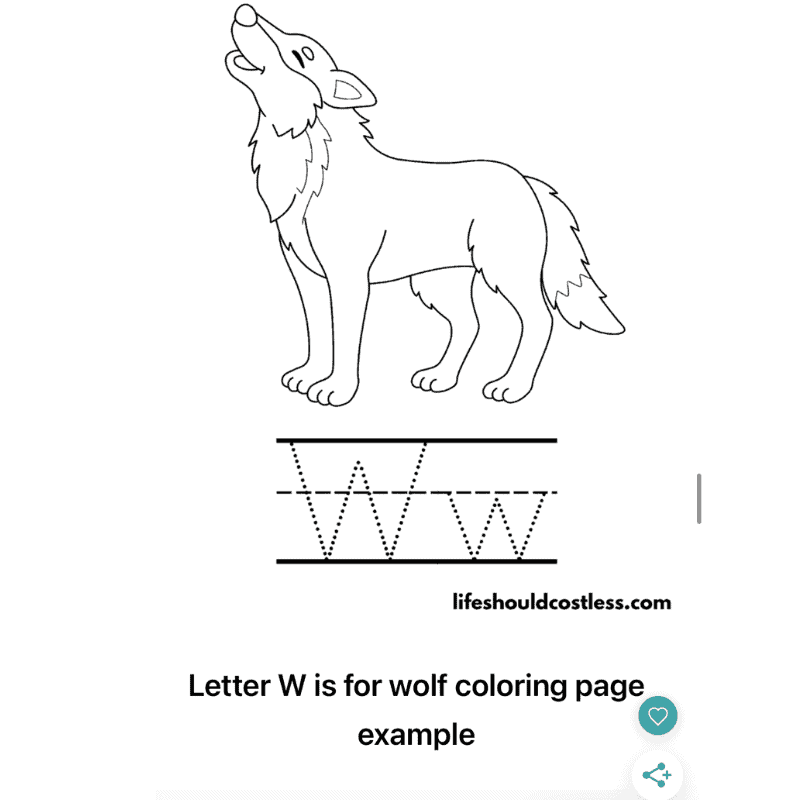 Browse through the assortment of coloring page choices and pick the image or images you'd like to color. The sample image(s) presented here, with the website's watermark visible at the bottom, offer you a glimpse of what the full PDF image will look like.</li><li>
Browse through the assortment of coloring page choices and pick the image or images you'd like to color. The sample image(s) presented here, with the website's watermark visible at the bottom, offer you a glimpse of what the full PDF image will look like.</li><li>  Look slightly below the desired sample image to find the "download here" button for the attached PDF file.</li><li>
Look slightly below the desired sample image to find the "download here" button for the attached PDF file.</li><li> 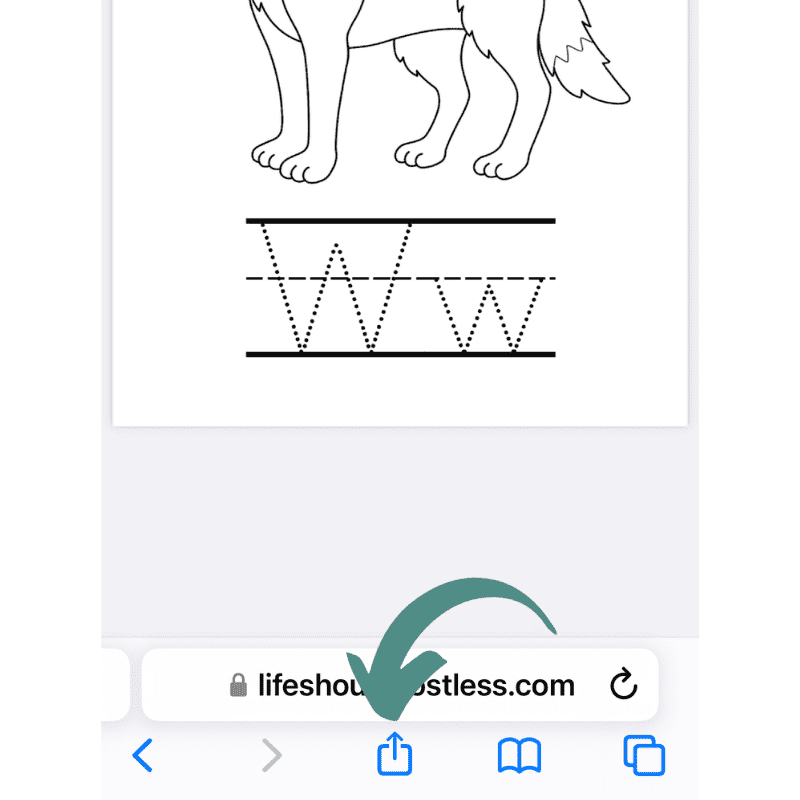
 First select download, and then select the option to print.</li><li>
First select download, and then select the option to print.</li><li> 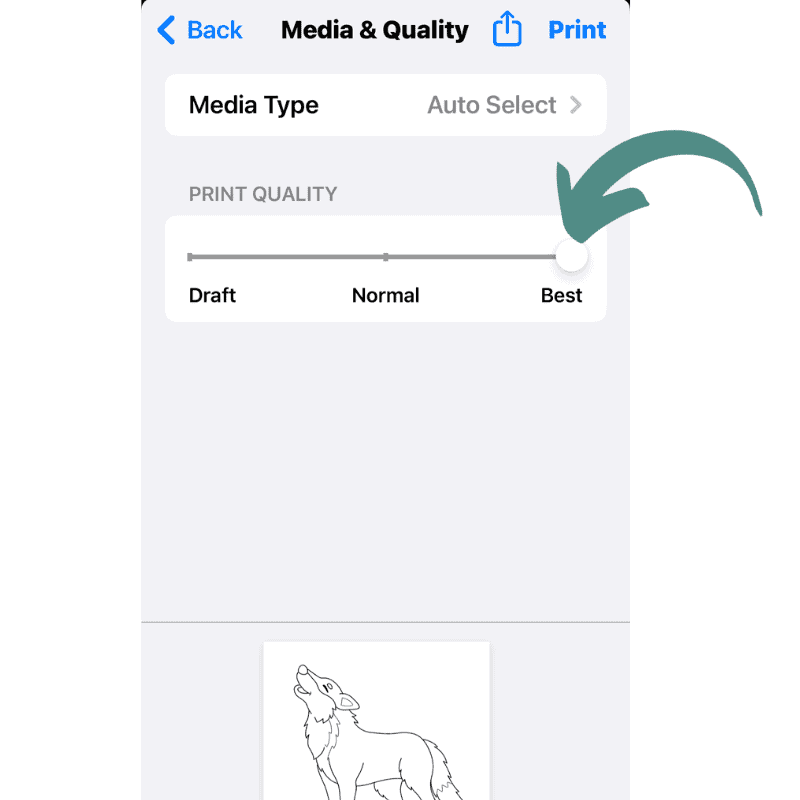 When you're ready to print, make sure that you select the highest-quality print setting available.</li><li>
When you're ready to print, make sure that you select the highest-quality print setting available.</li><li>  Now select "print". Then send it to your printer of choice.</li><li>
Now select "print". Then send it to your printer of choice.</li><li> 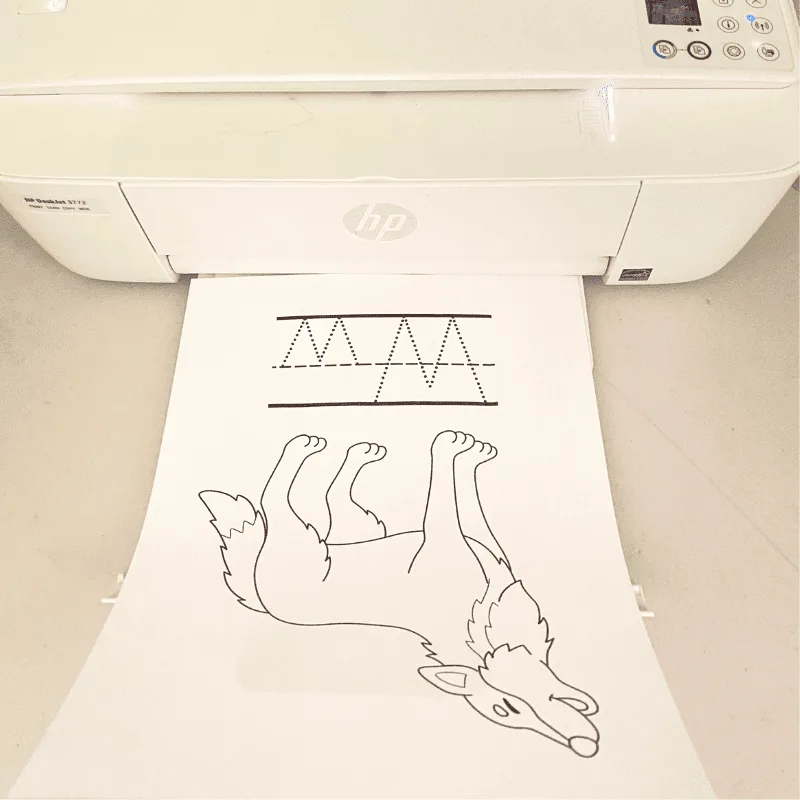 Once you have finished printing out your coloring sheet(s), give the ink a few minutes to fully dry while it's still on the printer. This extra step will prevent any ink smudging on your coloring page, which can be especially important if you plan to give your artwork to special someone.</li><li>
Once you have finished printing out your coloring sheet(s), give the ink a few minutes to fully dry while it's still on the printer. This extra step will prevent any ink smudging on your coloring page, which can be especially important if you plan to give your artwork to special someone.</li><li> 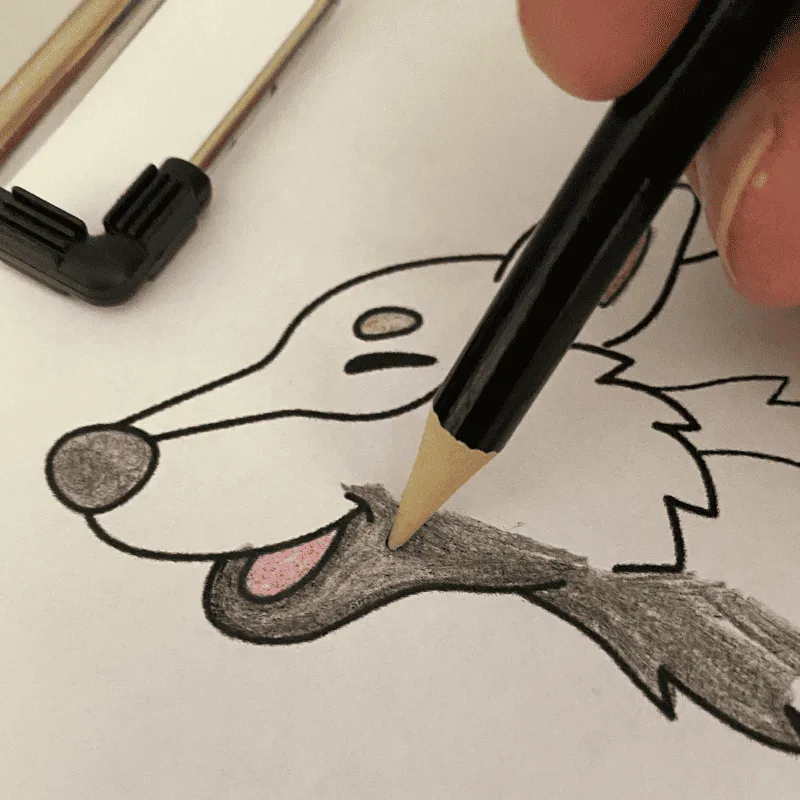 Before starting on your coloring adventure, please ensure your hands are washed well and completely dried. Next, find a clean, level surface on which to place your paper, and then let your imagination run free as you color up a storm. </li></ol><div><div><div><div><div><div></div></div></div></div></div></div><p></p><div><div><div><div><div><div></div></div></div></div></div></div><p></p><p></p><div><div><div><div><div></div></div></div></div></div><p></p><div><div><div><div><div></div></div></div></div></div><p></p>
Before starting on your coloring adventure, please ensure your hands are washed well and completely dried. Next, find a clean, level surface on which to place your paper, and then let your imagination run free as you color up a storm. </li></ol><div><div><div><div><div><div></div></div></div></div></div></div><p></p><div><div><div><div><div><div></div></div></div></div></div></div><p></p><p></p><div><div><div><div><div></div></div></div></div></div><p></p><div><div><div><div><div></div></div></div></div></div><p></p>
Notes
Ideas on what to do with these wolf pictures:
You could buy some simple frames, have the images printed out onto a quality card stock at a local printing company, color them as well as you can, and they could be added to your homes decor.
You could print out the images and bind them, pair them with some nice colored pencils or an art set,
which could serve as a unique gift idea for any occasion, particularly for individuals who have a love for coloring. It's a considerate gesture to bring a smile to someone's face or to provide happiness whenever the occasion calls for it.
They can double as a source of inspiration or as blueprints for crafting detailed fine-line tattoos.
These free wolf coloring pictures can also be used as embroidery patterns by simply using transfer sheets.
Naturally, you also have the choice to just print them out and enjoy endless hours of fun by coloring them as many times as you wish.
*The instructions, primarily designed for iPhone users with HP printers aiming to achieve the highest print quality, can also be applied similarly to a wide range of other devices.
**When possible, it is advisable to use the "fit to page" feature before printing to ensure that the complete image is effectively transferred to your printed coloring page.
***This website utilizes an image optimization technique for the sample illustrations provided. While this optimization enhances page loading speed, there is a slight compromise in terms of image quality. For optimal results, we recommend downloading and directly using the included PDF file. The sample image serves as a general visual preview, as navigating through an entire PDF may present challenges on certain devices, potentially limiting the ability to view the entire image in a single screenshot.
Recommended Products
Please note that I am an affiliate with Amazon.com. When you purchase through my suggested product links, the cost for you is the same but I do receive a small commission for everything in your shopping cart. Thanks so much for the support!
-
 Looney Zoo Temporary Tattoo Markers for Skin, 10 Body Markers + 20 Large Tattoo Stencils for Kids and Adults, Dual-End Tattoo Pens Make Bold and Fine Lines with Cosmetic-Grade Temporary Tattoo Ink
Looney Zoo Temporary Tattoo Markers for Skin, 10 Body Markers + 20 Large Tattoo Stencils for Kids and Adults, Dual-End Tattoo Pens Make Bold and Fine Lines with Cosmetic-Grade Temporary Tattoo Ink -
 Printworks Vanishing Embroidery Transfers, for White/Light-Colored Fabrics, 12 Sheets, Inkjet, 8.5 x 11 (00524)
Printworks Vanishing Embroidery Transfers, for White/Light-Colored Fabrics, 12 Sheets, Inkjet, 8.5 x 11 (00524) -
 eletecpro 12x16 Picture Frames Set of 5, Display 8x10 or 8.5x11 Photo Frame with Mat or 12x16 without Mat, Wall Gallery Poster Frames, Photo Frames Collage for Wall Display
eletecpro 12x16 Picture Frames Set of 5, Display 8x10 or 8.5x11 Photo Frame with Mat or 12x16 without Mat, Wall Gallery Poster Frames, Photo Frames Collage for Wall Display -
 U.S. Art Supply 163-Piece Mega Deluxe Art Painting, Drawing Set in Wood Box, Desk Easel - Artist Painting Pad, 2 Sketch Pads, 24 Watercolor Paint Colors, 24 Oil Pastels, 24 Colored Pencils, 60 Crayons
U.S. Art Supply 163-Piece Mega Deluxe Art Painting, Drawing Set in Wood Box, Desk Easel - Artist Painting Pad, 2 Sketch Pads, 24 Watercolor Paint Colors, 24 Oil Pastels, 24 Colored Pencils, 60 Crayons -
 PRINA Art Supplies 120-Color Colored Pencils Set for Adults Coloring Books with Sketchbook, Professional Vibrant Artists Pencil for Drawing Sketching Blending Shading, Quality Soft Core Oil Based
PRINA Art Supplies 120-Color Colored Pencils Set for Adults Coloring Books with Sketchbook, Professional Vibrant Artists Pencil for Drawing Sketching Blending Shading, Quality Soft Core Oil Based -
 Sacnahe Tattoo Transfer Stencil Machine Copier Printer Thermal Tattoo Kit Copier Printer With 20pcs Free Tattoo Stencil Transfer Paper Black (2023 Update Version)
Sacnahe Tattoo Transfer Stencil Machine Copier Printer Thermal Tattoo Kit Copier Printer With 20pcs Free Tattoo Stencil Transfer Paper Black (2023 Update Version)
Coloring tips
Coloring a picture of a wolf can truly be a delightful and creative endeavor. Here are some of my best tips and tricks to help you bring your wolf artwork to life:
- Reference Images: If possible, use reference images of real wolves to get a better understanding of their natural colors and markings. This can help you achieve a more realistic and accurate depiction.
- Choose the Right Materials: Select your coloring materials wisely. Colored pencils, markers, crayons, and even watercolors can all work well. Experiment with different mediums to achieve the desired effect.
- Blending: Learn to blend colors effectively. Blending can give your wolf’s fur a more realistic texture. Colored pencils, in particular, are great for blending by layering different colors and using a blending tool or your finger.
- Layering: Start with light colors as a base layer and gradually build up to darker shades. Layering allows you to create depth and dimension in the wolf’s fur. Use varying pressure when applying colors for a smoother transition.
- Texture and Fur: Pay attention to the direction of fur growth. Wolves have different fur textures in various parts of their bodies. Use fine lines or stippling techniques to mimic fur texture, especially around the neck, back, and tail.
- Highlights and Shadows: Add highlights with a white or light-colored pencil or marker to areas where light would naturally hit, such as the top of the head, shoulders, and back. Use darker shades for shadows in areas where light is less intense.
- Background: Consider the background when coloring your wolf. A well-chosen background can enhance the overall composition and create a more immersive scene. It could be a forest, snowy landscape, or any setting that complements the wolf’s habitat.
- Experiment with Colors: Don’t be afraid to get creative with colors. While gray and brown are common wolf colors, you can experiment with unusual colors or patterns for a unique artistic interpretation.
- Practice Patience: Coloring a detailed picture can be time-consuming, so be patient and take breaks as needed. Rushing through the process can lead to less satisfying results.
- Inspiration: Look at other artists’ wolf drawings and coloring pages for inspiration. You can find various styles and techniques that may inspire your own coloring choices.
- Protect Your Work: Once you’ve completed your masterpiece, consider using a fixative spray to prevent smudging and preserve your artwork.
- Experiment and Have Fun: Remember that coloring is a creative and enjoyable activity. Don’t be afraid to experiment with different techniques, colors, and styles. The most important thing is to have fun and express your artistic vision.
Whether you’re a beginner or an experienced artist, these tips and tricks can help you create stunning wolf pictures that showcase your artistic talent and appreciation for these magnificent creatures.
Options For Printing:
Letter W is for wolf writing practice worksheets
*The letter W is for wolf coloring sheet printables in my collection are exclusively tailored for classroom usage and stand out as the sole printable options on this page that require no written authorization for public use.
However, if someone asks you about their source, please send the link to this post along if anyone asks you where you got them. Thank you!
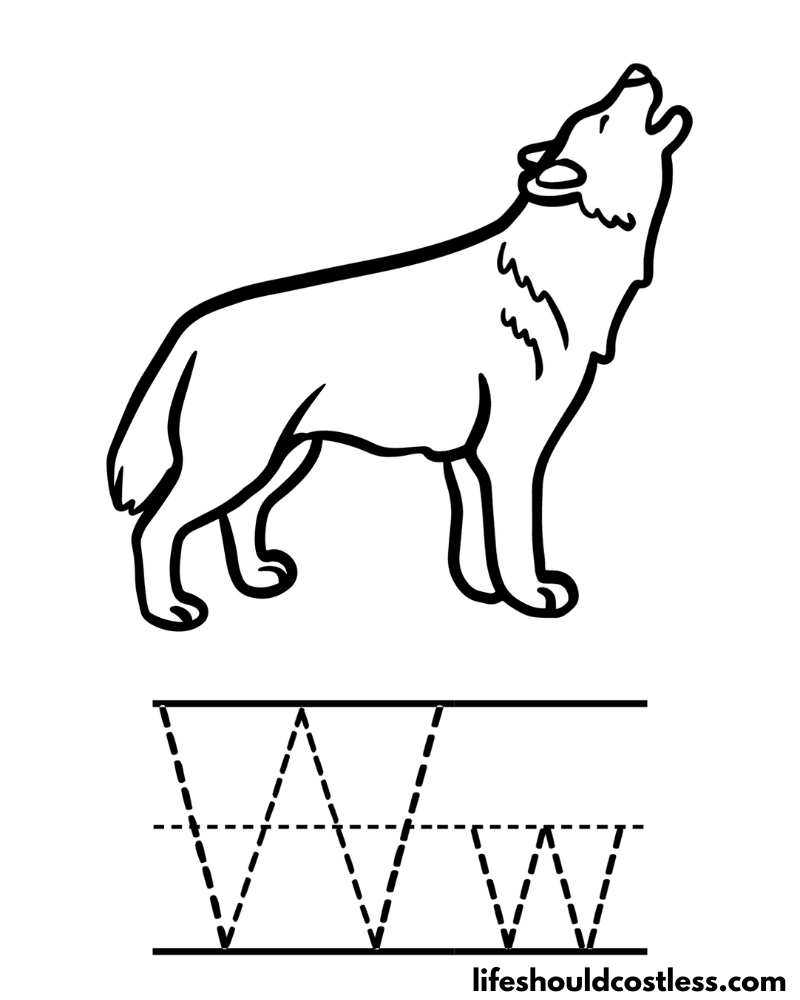
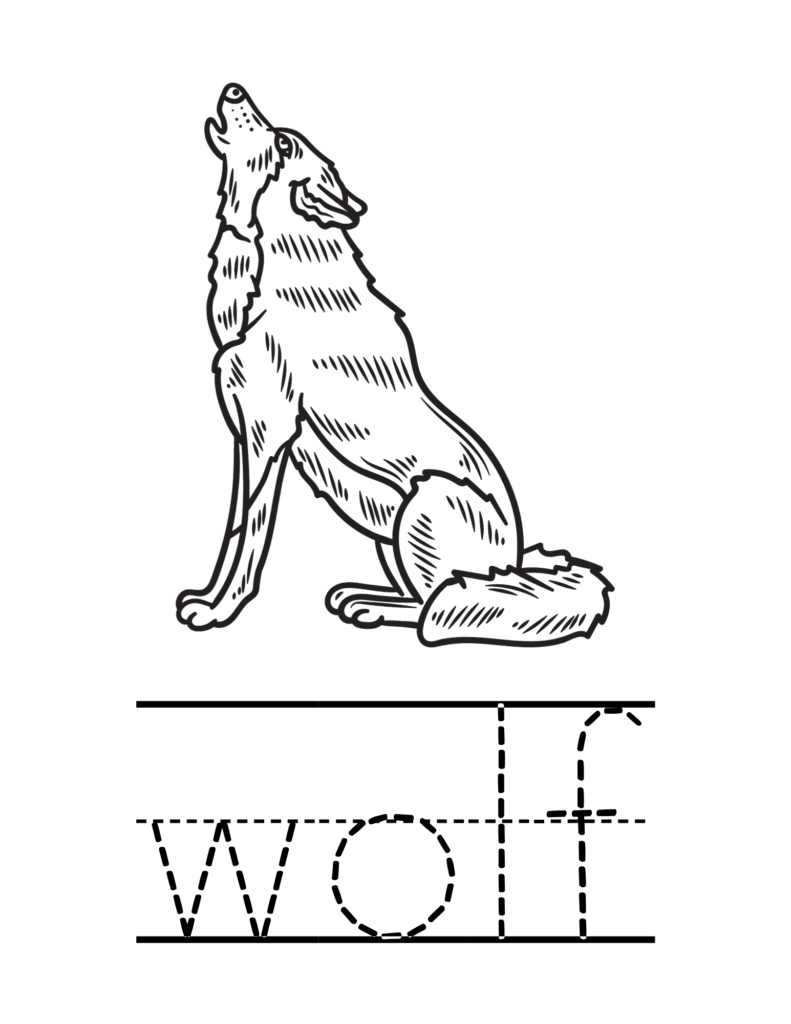
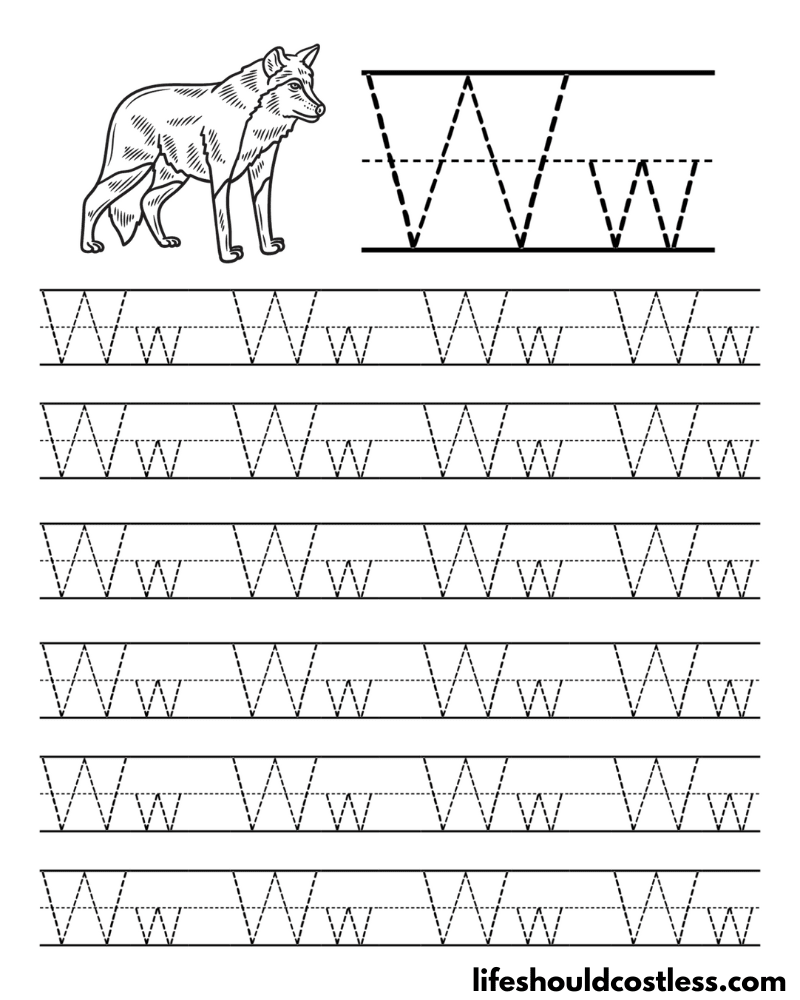
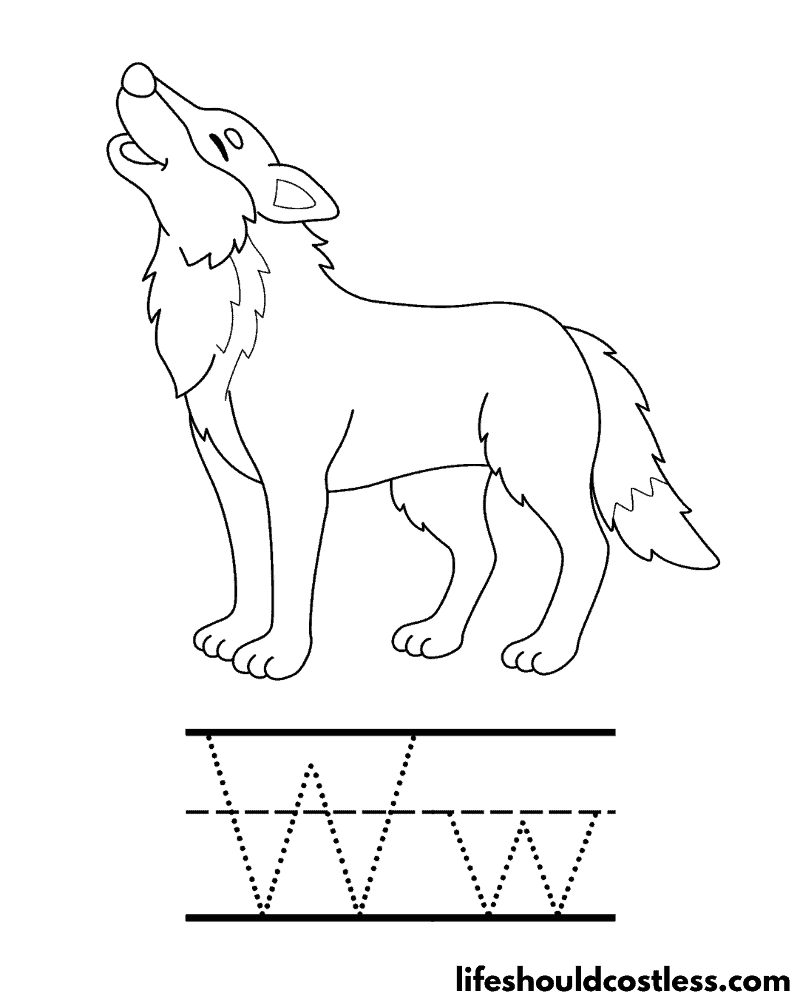
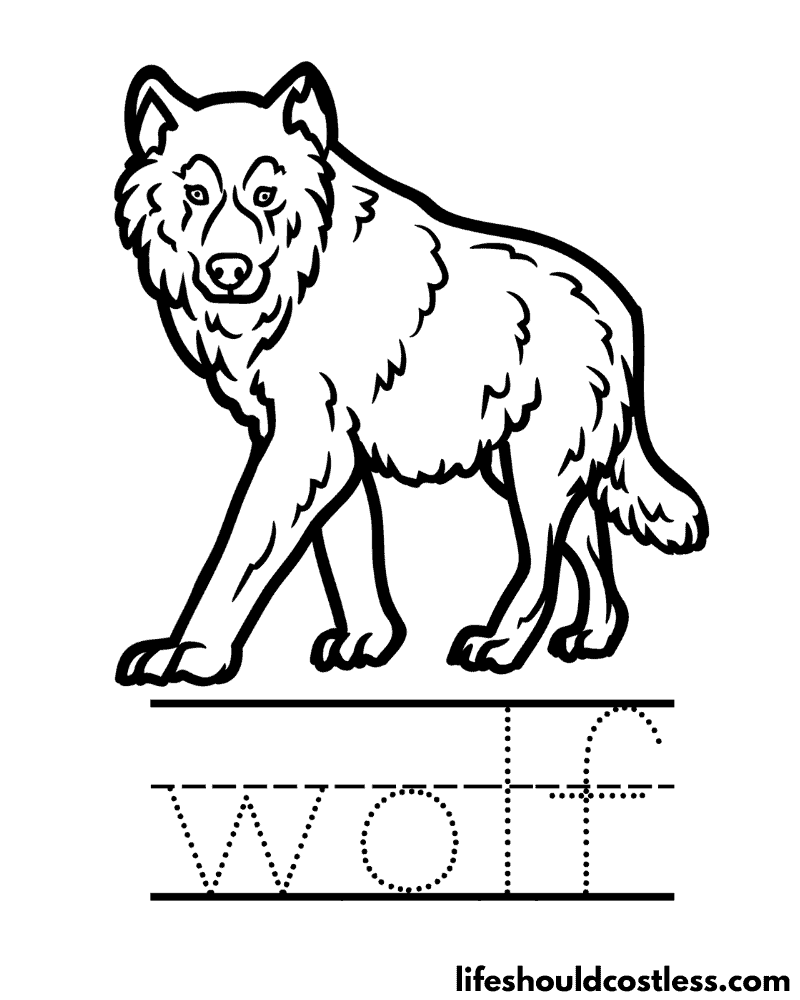
Various wolf designs
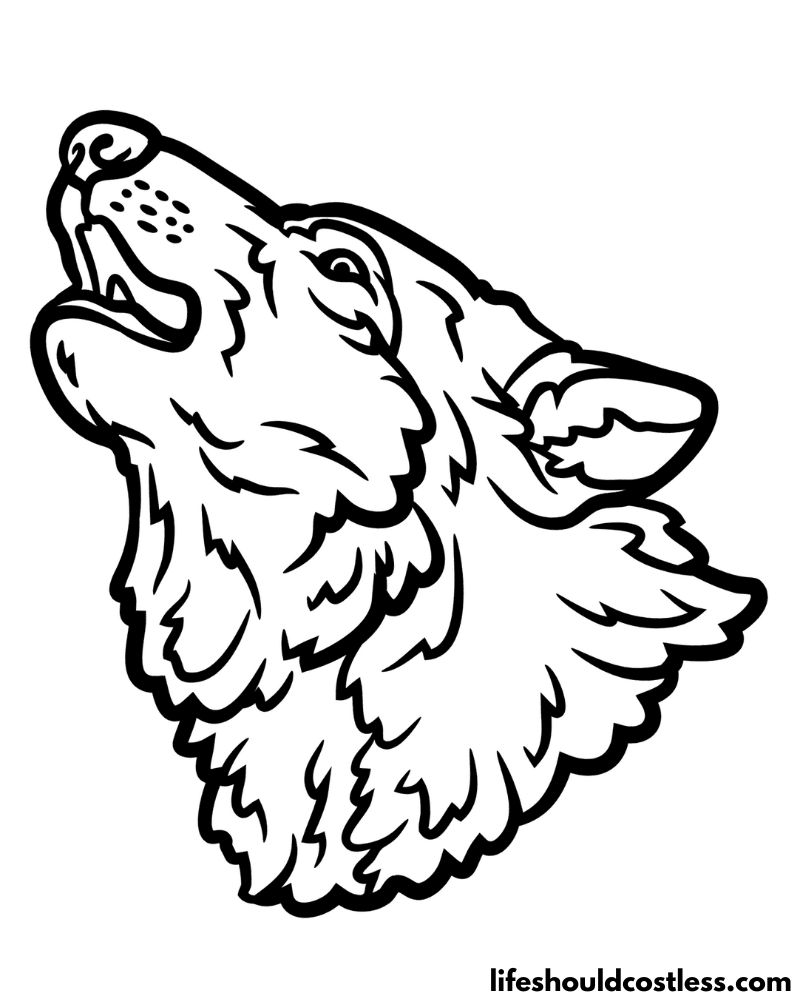
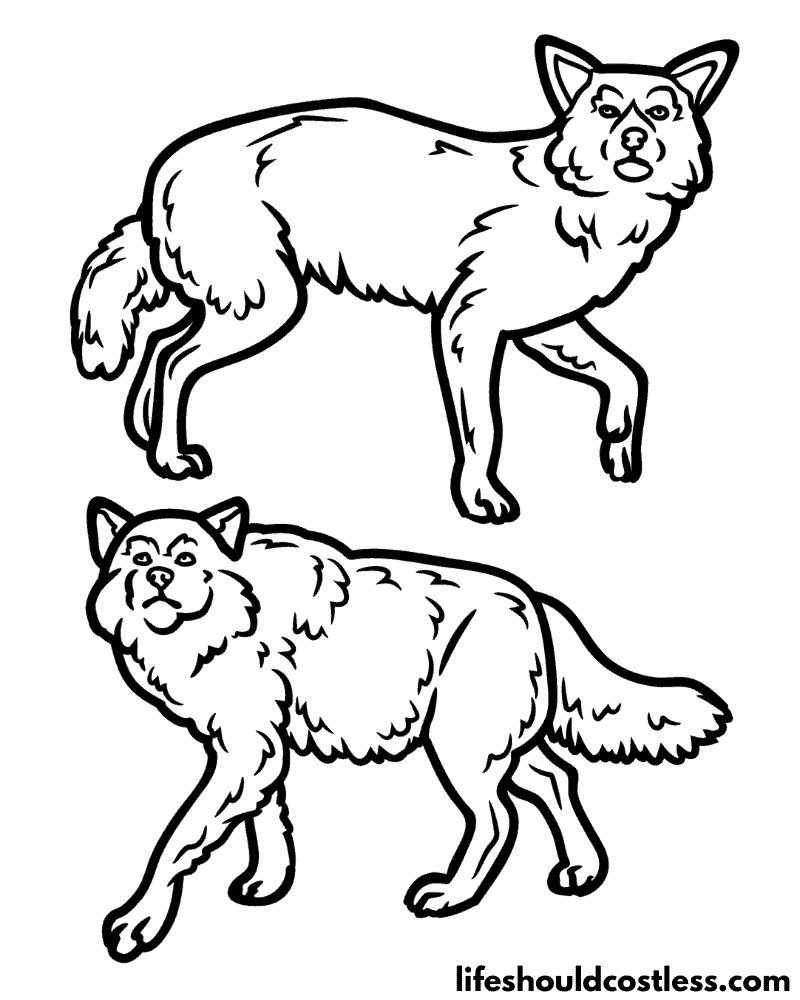
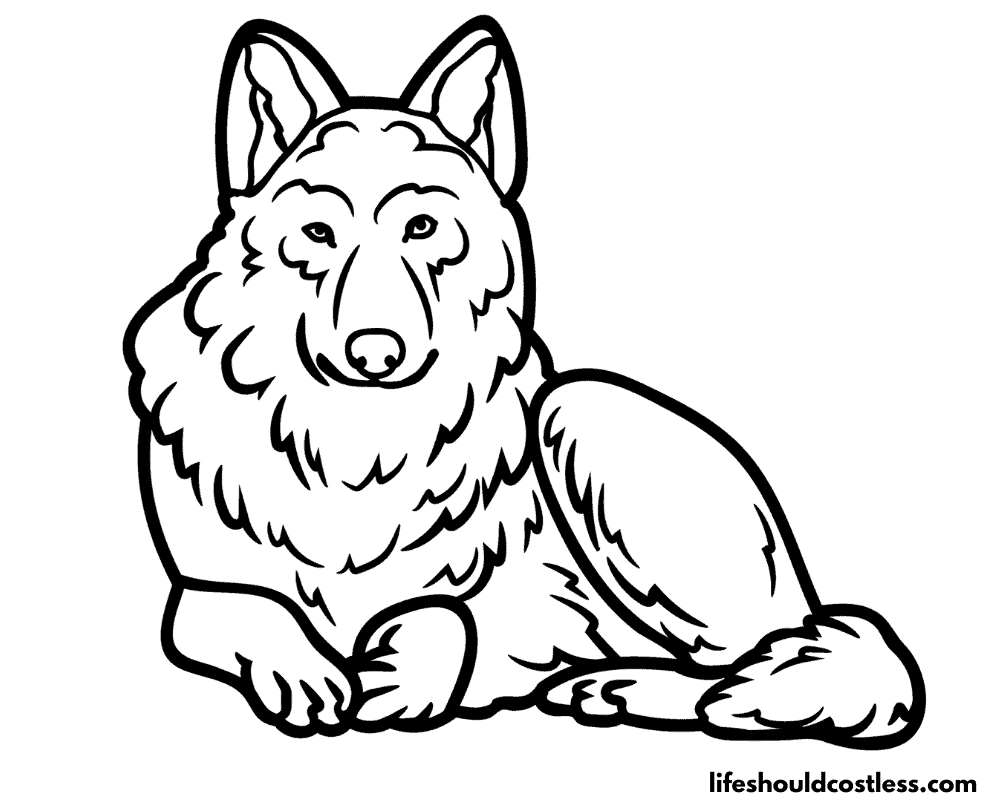
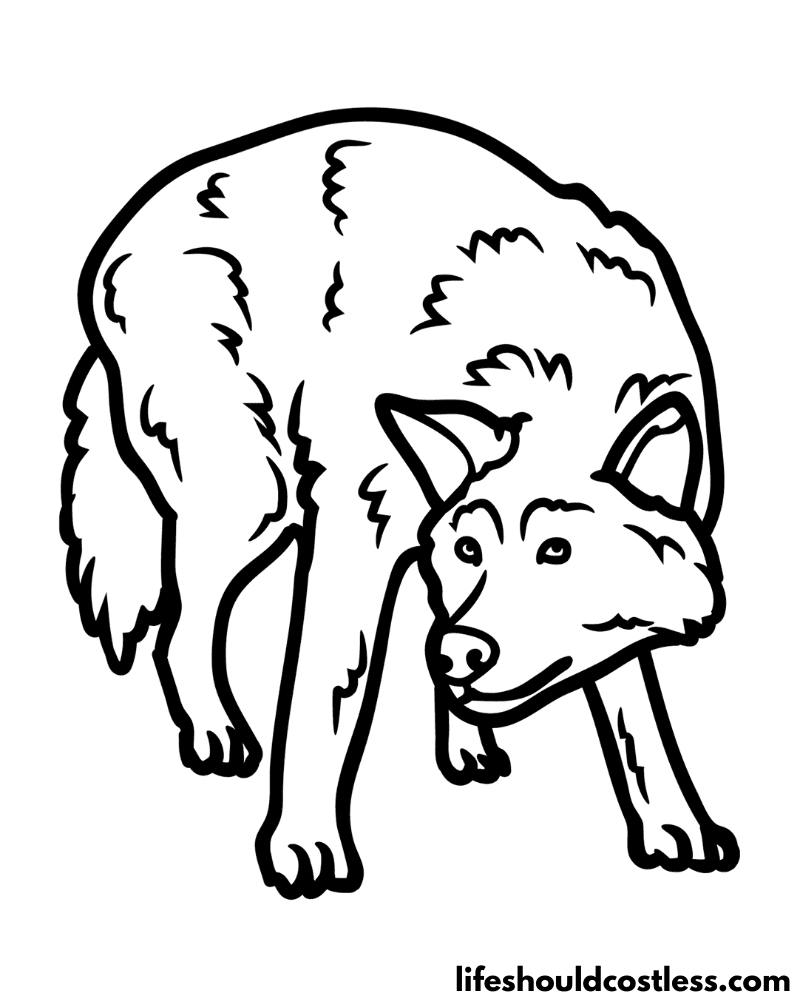
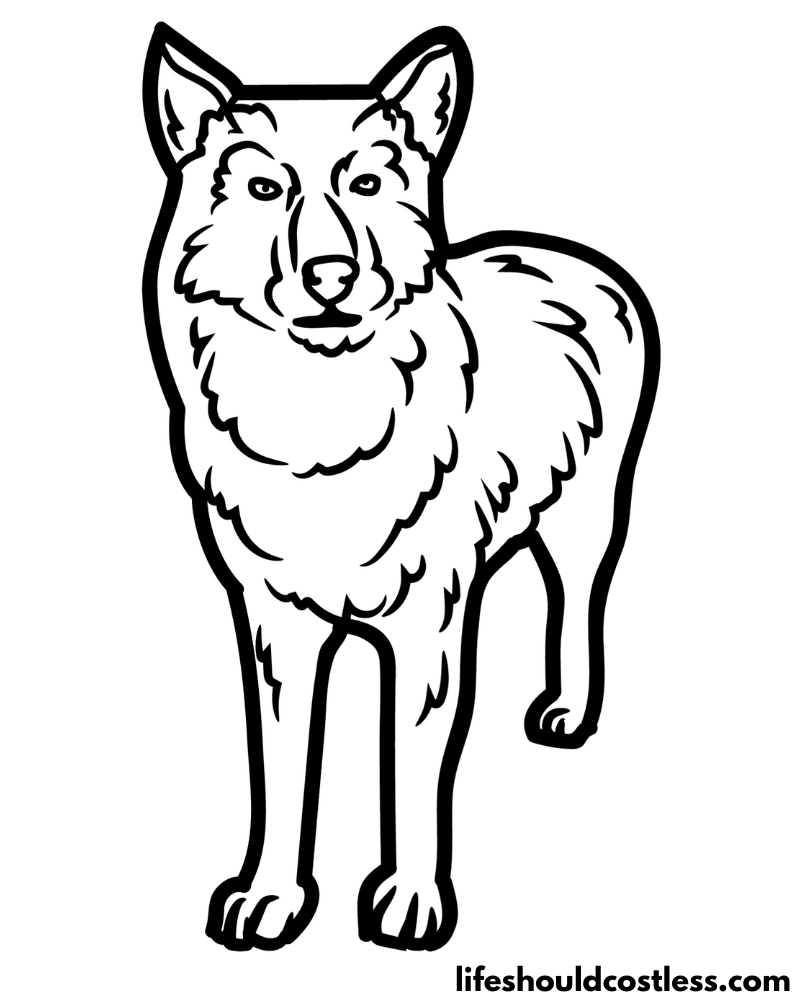
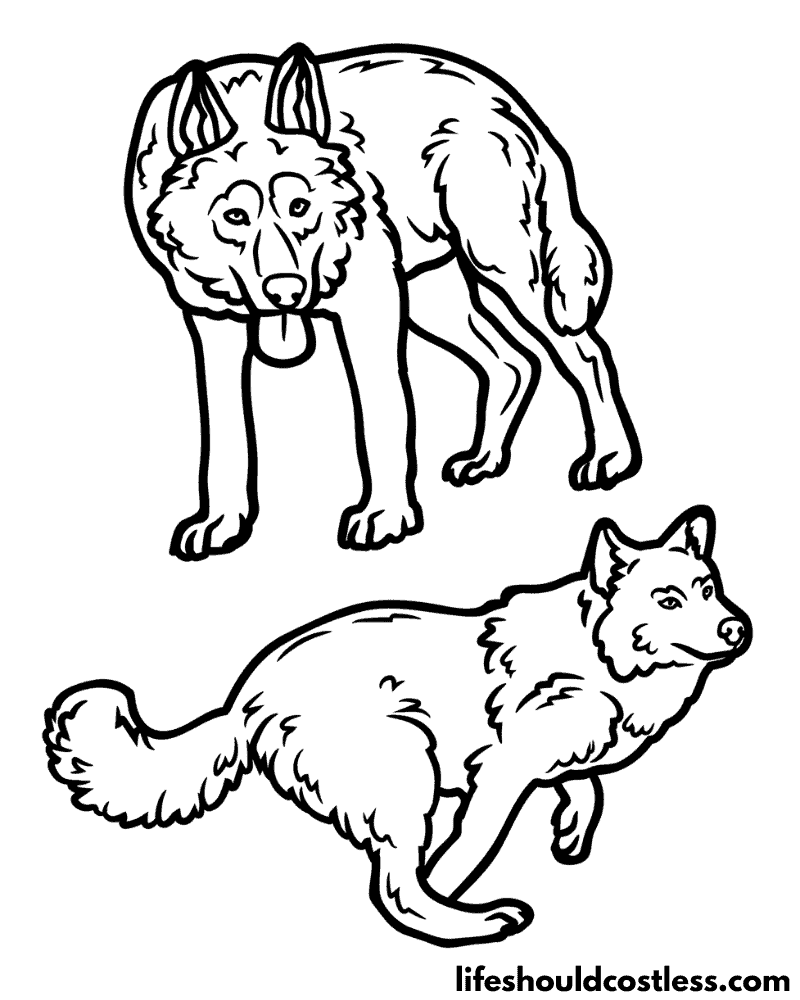

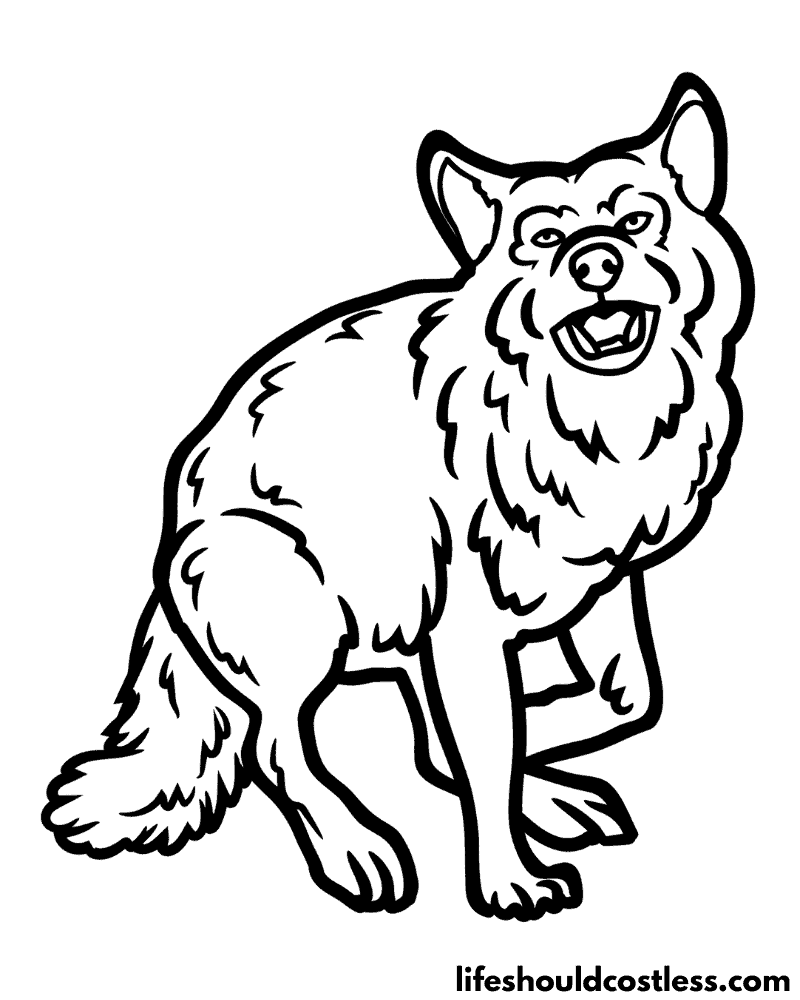
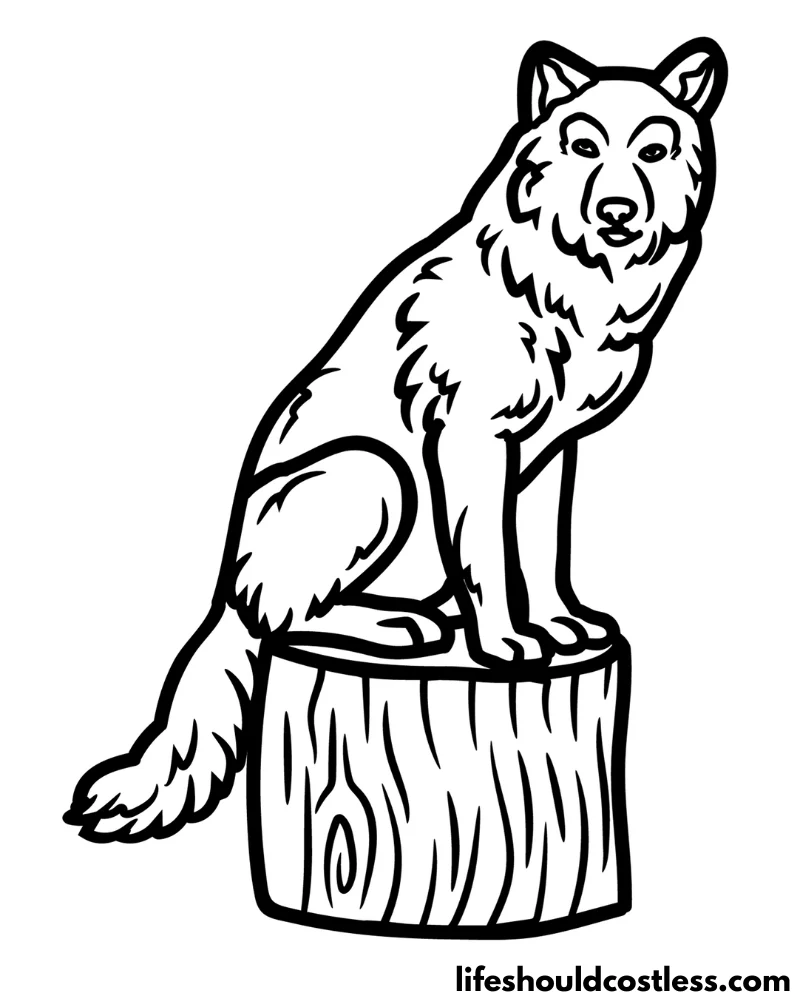
FAQ’s
The most common coloration for wolves is various shades of gray, which is why they are often referred to as “gray wolves.”
However, their coloration can vary depending on their location and subspecies. Gray wolves can range from light gray and almost white in the Arctic regions to dark gray and brown in more wooded or forested areas.
Other common colors among wolf populations include brown, black, and white, depending on their habitat and the time of year.
Wolves exhibit different colors and variations in their fur primarily due to a combination of evolutionary, ecological, and genetic factors. Here are some of the key reasons why wolves come in various colors:
Camouflage: The color of a wolf’s fur often serves as a form of camouflage, helping it blend into its natural environment. Gray wolves, for example, tend to have fur that matches the colors of their habitats, whether it’s the gray and white of the Arctic tundra or the darker gray and brown of forested areas.
Geographic Variation: Wolves have adapted to a wide range of habitats, from the snowy landscapes of the Arctic to the dense forests of North America. The variation in fur color helps them better suit their surroundings. This adaptation can also be influenced by seasonal changes, as some wolves may have lighter coats in winter to blend in with snow.
Genetic Diversity: The genetic makeup of wolf populations plays a significant role in fur coloration. Different subspecies and populations have developed unique color variations over time due to genetic diversity within their groups. These variations are often inherited from one generation to the next.
Predation and Climate: In some cases, fur color can be influenced by predation pressure and climate. Wolves in regions with a higher prevalence of predators may have evolved darker colors to better hide from potential threats. Similarly, the fur color of wolves in cold climates may be influenced by their need for insulation.
Mating Preferences: Mate selection can also impact fur coloration. Wolves may be more attracted to mates with certain fur colors, leading to the transmission of specific color traits within a population.
Hybridization: In some cases, hybridization with domestic dogs can introduce new fur color genes into wild wolf populations, leading to a wider range of colors in certain regions.
Overall, the diversity in wolf fur colors is a testament to their adaptability and their ability to thrive in a variety of environments.
It’s a remarkable example of how species can evolve and develop different traits to suit their specific ecological niches.
*I will add more wolf colour / color questions and answers as the questions get sent to me.
Conclusion
In the world of wolf coloring pages, we have journeyed through a territory where artistry meets education, and where the enigmatic allure of wolves comes to life through the strokes of color.
These coloring pages, designed to captivate both the young, and the young at heart, serve as a canvas for creativity and a window into the natural world.
As we conclude our exploration, we are reminded that the beauty of wolves extends far beyond their majestic appearances; it lies in their vital role as keystone predators, their intricate pack dynamics, and their enduring presence in cultures worldwide.
Through the act of coloring, we have not only unleashed our artistic expression but also gained a deeper appreciation for these magnificent creatures and their significance in our ecosystems.
So, whether you’re an artist, an educator, or simply a wolf enthusiast, these coloring pages continue to provide an avenue for connection, learning, and the celebration of the extraordinary world of wolves.
In each stroke of color, we honor their presence and commitment to the balance of nature, perpetuating their legacy one page at a time.
I greatly appreciate your visit to my blog and your support in my efforts to enhance people’s lives, whether by making things more convenient, better, or more cost-effective.
If you enjoyed this post or found it beneficial in any way, please consider sharing it with your family, friends, and colleagues through your social media networks or by sending them the direct link via email.
Whichever way you choose to spread the love, I super appreciate it! ~Sarah
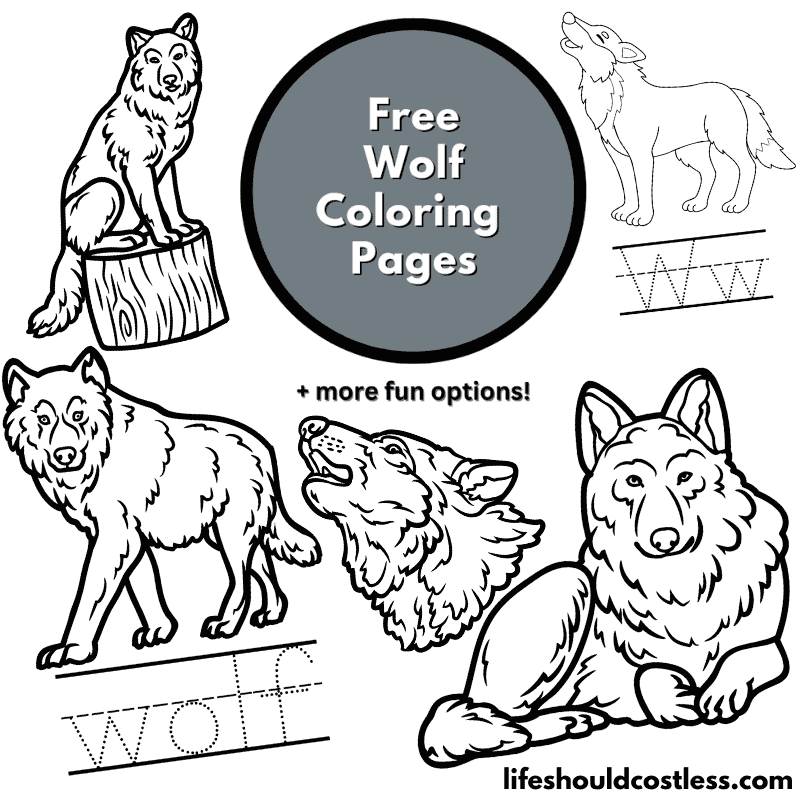
How To Follow & Support This Site
- If you would like to subscribe to my email list, go here.
- Make sure to follow along via social media, by going here.
- If you would like to learn how to really show your support to this site (at no cost to you), go here.
- If you would like to make a direct donation to the site, go here.
Check out my other free printables
- To see all of my free printables, go here.
- If you would like to see an alphabetized index of free printable coloring pages, go here!
- All of my animals coloring pages are found here.
- Or, my other mammals coloring pages can be found here.
Otherwise, here are direct links to several of my other related posts that you’re also going to love:
Animals / Mammals
Animals / Birds
Animals / Insects
Other good resources for a printable wolf
- https://www.colorwithfuzzy.com/wolf-coloring-pages.html
- https://clipart-library.com/printable-wolf-coloring-pages.html
- https://www.first-school.ws/theme/animals/cp_wild/cp_wolf.htm
*This post was originally shared to this blog on 09/25/2023, and has since been updated to improve user experience, add video instruction, as well as to make it as shareable as possible across the social medias.
**Please note that I do try my hardest to provide factual, but easy to understand, information about each topic. If you notice a discrepancy in my coloring pages, facts, or see something that you deem “misinformation/incorrect” please make sure to notify me about it. I would prefer that you send me an email with a link to a more reputable resource on that subject, so that I can correct it as soon as possible. Thanks so much for helping this site become the best that it can be!
***Resources from djinkers were used in the production of this article.
